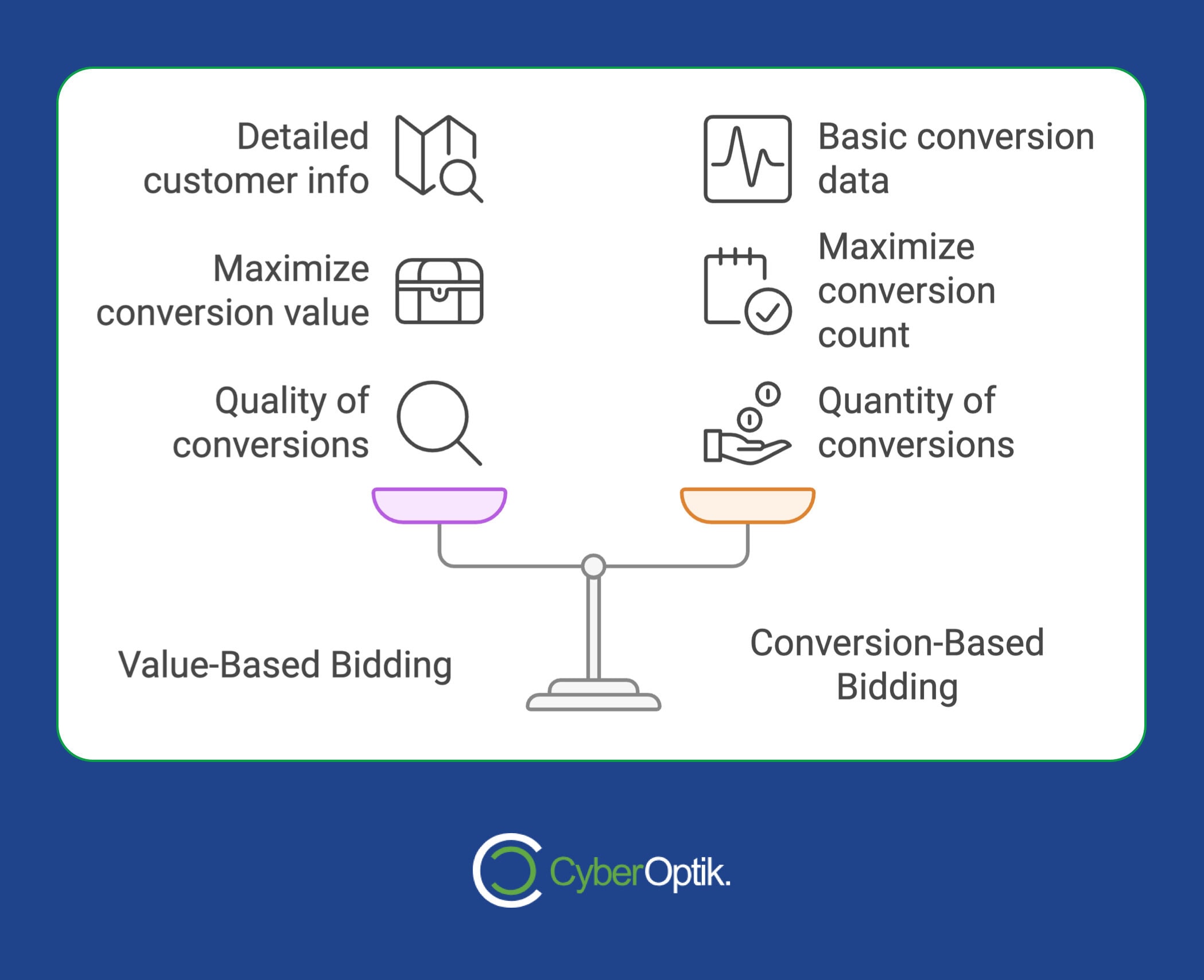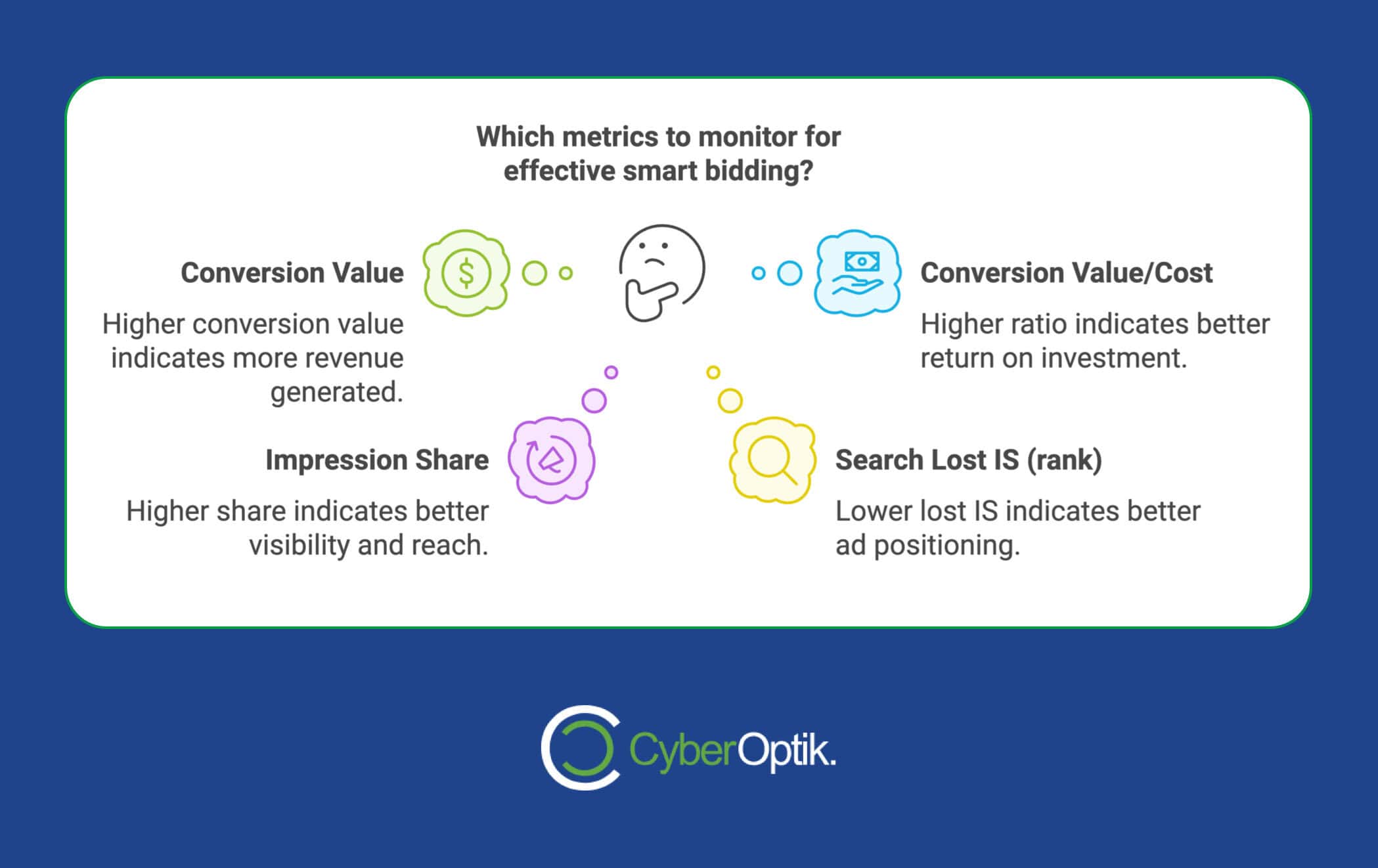Value-based bidding is a smart Google Ads strategy that focuses on maximizing the value of conversions, not just their quantity. Here’s what you need to know:
- It tells Google which customers are worth more to your business
- Aims to find high-value customers likely to make bigger purchases
- Uses machine learning to optimize ad spend based on conversion value
Key components:
- Setting Target ROAS (Return on Ad Spend)
- Creating value rules to assign different values to conversions
- Tracking both small and large conversions
- Monitoring key metrics like Conversion Value and Impression Share
Benefits:
- More efficient ad spending
- Focus on quality over quantity of conversions
- Works for various business types, not just e-commerce
To get started:
- Ensure good data quality and accurate conversion tracking
- Set clear conversion values based on customer actions
- Connect your CRM for better data integration
- Use your own customer data to refine targeting
Remember: Value-based bidding needs time to learn and optimize. Be patient and avoid making big changes too quickly.
Quick Comparison: Value-Based vs. Conversion-Based Bidding
| Feature | Value-Based Bidding | Conversion-Based Bidding |
|---|---|---|
| Focus | Quality of conversions | Quantity of conversions |
| Goal | Maximize conversion value | Maximize conversion count |
| Data Used | Detailed customer info | Basic conversion data |
| Ideal For | Businesses with varying customer values | Businesses where all conversions are equal |
| Complexity | More complex setup | Simpler setup |
| Machine Learning | Advanced | Basic |

Setting a data strategy for value-based bidding
Setting a data strategy for value-based bidding
Getting Started with Value-Based Bidding
Value-based bidding can supercharge your ad spend ROI. Here’s how to set it up for your digital marketing campaigns:
Checking Your Data Quality
First things first: make sure your data is up to snuff. Google’s machine learning needs good data to work its magic. So:
- Double-check your conversion tracking
- Make sure your privacy settings are on point
- Regularly audit your tracking setup
The better your data, the better your results. Simple as that.
Setting Conversion Values
Now, let’s talk money. You need to tell Google what different customer actions are worth to you. Here’s the deal:
- Figure out what matters
What customer actions actually move the needle for your business?
- Put a price tag on it
How much is a contact form submission worth? What about a service inquiry?
- Track those values
Use Google Ads settings, data layer events, or hook up your CRM to record these values.
For example, you might say a website redesign inquiry is worth $50, while a custom WordPress design request is worth $100. It all depends on your business.
Connecting with Your CRM
Hooking up your CRM to Google Ads? Smart move. Here’s how:
- Go to “Tools and Settings” in Google Ads
- Click “Linked Accounts” under Setup
- Pick your CRM from the list
- Follow the prompts
Once you’re connected, match up your conversion actions with your CRM milestones. This gives Google access to the good stuff – your customer data.
Using Your Own Customer Data
Your first-party data is gold. Use it to refine your targeting and boost conversion value. Here’s the game plan:
- Get your data in order
Organize your customer info in a spreadsheet. Make sure it’s formatted right for upload.
- Grab the Customer List template
Google’s got a template to help you structure your data correctly.
- Upload and segment
Import your data into Google Ads and create audience segments based on customer traits or behaviors.
Parts of Smart Bidding
Smart bidding isn’t just about setting a target and letting Google take the wheel. It’s a complex system with several key components. Let’s break it down:
Setting Target ROAS
Target ROAS is the heart of value-based bidding. It tells Google how much value you want back for every ad dollar spent. Here’s how to set it right:
- Check your past ROAS
- Factor in your profit margins
- Test different targets
KitchenLab, a premium kitchenware retailer, boosted their ROAS by 46% over three months. How? They fine-tuned their product feed and zeroed in on their most profitable items. This let them set higher ROAS targets for high-value products while staying profitable across the board.
Creating Value Rules
Value rules are the secret weapon of smart bidding. They let you assign different values to conversions based on specific criteria. Here’s the process:
- Figure out what drives value for your business
- Set up rules in Google Ads
- Keep an eye on performance and adjust as needed
A pest control retailer saw a massive 451% ROAS improvement after switching to DataFeedWatch for their product feed. This allowed for better categorization and management, leading to more precise value rules based on product types and seasonal demand.
Tracking Small and Large Conversions
Every conversion counts, but they’re not all equal. Here’s how to track them:
- Micro-conversions: Small actions like newsletter sign-ups
- Macro-conversions: Big wins like purchases or high-value leads
Use Google Analytics to set up goals for both types. This gives you a full picture of your customer journey.
Pro tip: Google says you need at least 15 conversions in 30 days for Target ROAS to work well. If you’re falling short, try tracking more micro-conversions.
Key Numbers to Watch
Smart bidding does a lot, but you still need to keep tabs on these metrics:
- Conversion Value
- Conversion Value/Cost
- Impression Share
- Search Lost IS (rank)

An NYC fashion brand shows how focusing on these numbers pays off. By testing product title variations in their Google Shopping campaigns and watching these metrics closely, they bumped up their ROAS by 25%.
Smart bidding is powerful, but it’s not a “set it and forget it” tool. By mastering these key components, you can make sure your campaigns aren’t just running – they’re thriving.
Making Your Bidding Better
Value-based bidding packs a punch, but it’s not a set-and-forget tool. Let’s explore how to squeeze every drop of performance from your campaigns.
Sharing Data Correctly
Your bidding success depends on feeding Google’s algorithms high-quality data. Here’s how to do it right:
- Global Site Tag and Google Tag Manager
These tools are your best friends for tracking online data. They help you keep tabs on what users do on your site and send that info back to Google Ads.
- Offline Conversion Imports
Got a business that closes deals offline? This feature’s for you. It lets you report on conversion paths without compromising customer privacy.
- CRM Connection
Link your Customer Relationship Management system to Google Ads. It’s like giving Google a treasure trove of data to work with.
“Good conversion data can make or break your value-based bidding. Set up conversions that actually match what your business cares about.” – Google Ads Expert
How to Set Values
Putting the right price tag on customer actions is key. Here’s how to nail it:
Start with your average sale value. If you’re selling $100 widgets at a 20% profit margin, each sale might be worth $20 to your ads.
But don’t stop there. Think about lifetime value. A customer who buys small stuff often might be worth more than a one-time big spender.
Not all conversions are created equal. A newsletter signup might be worth $5, but a demo request could be $50.
And remember, these values aren’t set in stone. Keep an eye on your business performance and adjust as needed.
Picking the Right Attribution Model
Your attribution model tells you which ads are really driving sales. Here are your options:
Data-Driven Attribution: This is Google’s fancy machine learning model. It spreads the credit for a sale across all the ads that played a part.
Last Click: All the credit goes to the last ad clicked before the sale. Simple, but it might not tell the whole story.
First Click: The opposite of last click. It gives all the credit to the first ad someone interacted with.
Linear: This model splits the credit evenly across all ad interactions. It’s fair, but might not reflect reality for every business.
“As digital marketers, we need to really get our clients’ businesses. What are they trying to achieve?” – Jess Weber, Director of Account Performance at HawkSEM
Testing What Works
To keep improving your bidding strategy, you’ve got to test and optimize. Here’s how:
Build up your conversion history first. Google says you need at least 45 conversions in the last 30 days for the conversion action you’re working on.
Don’t make big changes all at once. If you’re tweaking your target ROAS, don’t change it by more than 20% at a time. And give it at least two weeks before you make another change.
Try some A/B testing. See how different ads, landing pages, or bidding strategies stack up against each other.
Keep your eyes on the important stuff: conversion value, conversion value/cost, impression share, and search lost IS (rank).
Common Problems and Solutions
Value-based bidding can be tricky. Let’s look at some common issues and how to fix them.
Fixing Data Problems
Bad data leads to bad results. Here’s how to keep your data clean:
- Tracking Issues: Set up conversion tracking correctly across all platforms. Use Google Tag Manager to keep everything in sync.
- Duplicate Conversions: Remove any duplicate conversion actions. They can mess up your data.
- Missing Offline Conversions: Don’t forget about offline sales! Set up offline conversion imports to give Google the full picture.
“Smart Bidding troubleshooting needs a proactive approach, constant monitoring, and data-driven decisions.” – FasterCapital Team
Dealing with Complex Values
Some conversions are hard to value. Here’s how to handle them:
Long Sales Cycles: For B2B companies, assign values to different funnel stages. A demo request might be $50, while a qualified sales call could be $200.
Subscription Models: Look at lifetime value. A $10/month subscription might seem small, but if customers stay for two years, that’s $240 in value.
Product Bundles: Break down the value of each part. For computer packages, assign separate values to the PC, monitor, and peripherals.
Getting Through the Learning Phase
The learning phase can be tough, but stick with it:
- Be Patient: Google needs at least 30 conversions (50 for Target ROAS) in 30 days for smart bidding to work well. Don’t worry if performance dips at first.
- Don’t Make Big Changes: Let the system learn without interference.
- Watch, But Don’t Panic: Keep an eye on things, but don’t make quick changes. Wait at least two weeks before doing anything major.
Avoiding Analysis Mistakes
It’s easy to misread data. Here’s how to stay on track:
- Don’t Jump to Conclusions: Don’t analyze too early in the learning phase. Google’s 2021 data shows patience pays off, with search campaigns seeing a 14% boost in conversion value at similar ROAS when using Maximize Conversion Value.
- Look at the Big Picture: Don’t focus on daily changes. Look at trends over 7-30 day periods.
- Compare Fairly: When comparing performance, look at similar time periods and consider seasonal factors.
- Set Realistic Goals: Start with a recommended tROAS based on past performance. As the Optmyzr Team says,
“Don’t set your ROAS goal too high.”
Measuring Results
Value-based bidding can boost your ad campaigns. But you need to track the right metrics. Here’s how to measure success and keep improving.
Key Metrics to Watch
For value-based bidding, focus on these numbers:
- Conversion Value: The total value of all conversions. It’s your big-picture metric.
- Return on Ad Spend (ROAS): Revenue generated per ad dollar spent. If you spend $1,000 and make $10,000, your ROAS is 10.
- Cost Per Acquisition (CPA): What you pay for each conversion. It shows if your ad spend is efficient.
- Click-Through Rate (CTR): Percentage of people who click your ad after seeing it. Most industries average 6-7% CTR.
Checking Performance
Don’t just look at numbers. Check performance like this:
- Use Google Ads Dashboard
Set it up to show key metrics at a glance. It’s your command center.
- Look at Trends
Don’t sweat daily changes. Focus on 7-30 day trends instead.
- Compare Similar Periods
Look at similar time frames. Consider seasonal factors.
- Be Patient
Give Google’s machine learning at least two weeks before making big changes.
“Smart Bidding needs constant monitoring and data-driven decisions.” – FasterCapital Team
Improving Your Results
Keep getting better with these tips:
- Optimize Landing Pages
If CTR is good but conversions are low, your landing page might be the issue. Test different layouts and copy.
- Refine Keywords
Replace low-performing keywords. Try long-tail keywords for targeted traffic.
- Adjust Bidding
If ROAS is low, tweak your strategy. Change your target ROAS in small steps (max 20% at a time).
- Use Conversion Value Rules
Assign different values to conversions based on criteria. A pest control retailer saw 451% ROAS improvement using DataFeedWatch for precise value rules.
Making Sense of Data
Understand your results:
- Look at the big picture. See how metrics work together.
- Consider your goals. High CTR isn’t always good if it doesn’t lead to valuable conversions.
- Use benchmarks. If your CTR beats the 6-7% industry average, you’re doing well.
- Plan next steps. Based on your analysis, decide what to change – ad copy, targeting, or conversion values.
Summary
Value-based bidding is changing the game in digital advertising. It’s not just about clicks or conversions anymore – it’s about squeezing the most value out of every customer interaction.
Here’s why it’s a big deal for your business:
Smarter Spending: Value-based bidding uses machine learning to optimize your ad spend based on conversion value, not just volume. You’re investing in customers who’ll likely bring the most value to your business.
Real Results: Kia U.K.’s experience shows the power of this approach:
After implementing value-based bidding, Kia U.K. saw a 20% increase in value, 10% reduction in cost-per-acquisition, and 13% boost in conversion rate.
These numbers speak for themselves.
Bridging the Information Gap: Unlike traditional conversion-based bidding, value-based bidding lets you tell Google which customers are worth more. This leads to more efficient ad spending.
Not Just for E-commerce: As Optmyzr points out:
“Bidding to value works for a wide variety of advertising goals, but because it uses a target ROAS, it’s sometimes incorrectly assumed that it’s only for ecommerce.”
Businesses of all types can benefit from this approach.
Data-Driven Decisions: Value-based bidding thrives on good data. By sharing better information with Google – including both online and offline conversions – you help the system understand the true value of each customer interaction.
Automated Efficiency: Once set up, value-based bidding runs on autopilot. This frees up your time to focus on other aspects of your marketing strategy.
To make the most of value-based bidding:
- Set Clear Values
Assign conversion values based on estimated worth, implementation, and frequency.
- Build Value Rules
Create rules for conversion values based on factors like location, audience, and device.
- Monitor and Adjust
Regularly review your performance and tweak your target ROAS or CPA as needed.
- Be Patient
Google’s 2021 data shows that patience pays off. Search campaigns using value-based strategies saw a 14% lift in conversion value at similar ROAS.
Value-based bidding isn’t just a trend – it’s a smarter way to advertise. By focusing on value over volume, you can make your ad spend work harder for your business.
FAQs
Conversion-based vs. Value-based Bidding: What’s the Difference?
Conversion-based bidding is all about getting as many conversions as possible. Value-based bidding? It’s about getting the most valuable conversions.
Think of it like fishing. Conversion-based is catching as many fish as you can. Value-based is focusing on catching the big, prized fish.
If you’re selling both cheap and expensive products, value-based bidding helps you reel in those big spenders. It’s about spending your ad money wisely to catch the customers who’ll bring in more profit.
Smart Bidding vs. Manual Bidding: How Do They Differ?
It’s all about control and automation:
- Manual bidding: You’re in the driver’s seat. You set and adjust bids yourself. More control, but more work.
- Smart bidding: It’s like having a robot co-pilot. Uses machine learning to optimize bids automatically. Less work for you, but can be unpredictable when things change.
Here’s a pro tip: When you make big changes to your campaign with smart bidding (like changing your budget), it can trigger a “learning phase”. Your performance might wobble a bit during this time.
What Are the 4 Types of Smart Bidding?
Google Ads offers four flavors of smart bidding:
- Target CPA: Aims to get you as many conversions as possible at your target cost per acquisition.
- Target ROAS: Focuses on hitting your desired return on ad spend.
- Maximize Conversions: Tries to get you the most conversions within your budget.
- Maximize Conversion Value: Aims for the highest total conversion value within your budget.
Each strategy fits different goals. Selling high-end products? Maximize Conversion Value might be your best bet.
“Smart Bidding Strategies aren’t a magic wand for more conversions or revenue. But they’re a great way to test what’s possible for your account.” – AJ Gallion, PPC Specialist at Forthea
Choosing a smart bidding strategy? Think about your business goals, what you’re selling, and who you’re selling to. And here’s a tip: Start with manual bidding. Gather data for 30 to 90 days before jumping into smart bidding. It’s like giving your smart bidding strategy a head start.




